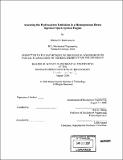Assessing the hydrocarbon emissions in a homogeneous direct injection spark ignited engine
Author(s)
Radovanovic, Michael S
DownloadFull printable version (10.41Mb)
Alternative title
Assessing the HC emissions in a homogeneous DISI
Other Contributors
Massachusetts Institute of Technology. Dept. of Mechanical Engineering.
Advisor
Wai K. Cheng.
Terms of use
Metadata
Show full item recordAbstract
For the purpose of researching hydrocarbon (HC) emissions in a direct-injection spark ignited (DISI) engine, five experiments were performed. These experiments clarified the role of coolant temperature, injection pressure, and injection timing in HC emissions; the final two experiments illustrated the effect of coolant temperature and injection pressure on separate sweeps of injection timing and the subsequent HC levels. The first three experiments were performed with isopentane. All five of the experiments were repeated with two fuels: UTG 91, a typical research gasoline, and a fuel with a high driveability index (DI), i.e. a less volatile fuel. The results showed less-than intuitive results for the response of HC to varying coolant temperature and varying injection pressure. For the coolant temperature data, the deviation from intuition is discussed and is probably due to vaporization problems. For the injection pressure results, the counterintuitive trend is expected to be the balance of two negative effects of high and low fuel pressure: high droplet velocities and large droplet diameters. Finally, the injection timing results were more logical. The early injections are high for this engine due to late exhaust valve closing, and the late injections have high HC because of a decreasing time to vaporize and poor mixing caused by the lack of intake air motion.
Description
Thesis (S.M.)--Massachusetts Institute of Technology, Dept. of Mechanical Engineering, 2006. Includes bibliographical references (p. 80-81).
Date issued
2006Department
Massachusetts Institute of Technology. Department of Mechanical EngineeringPublisher
Massachusetts Institute of Technology
Keywords
Mechanical Engineering.